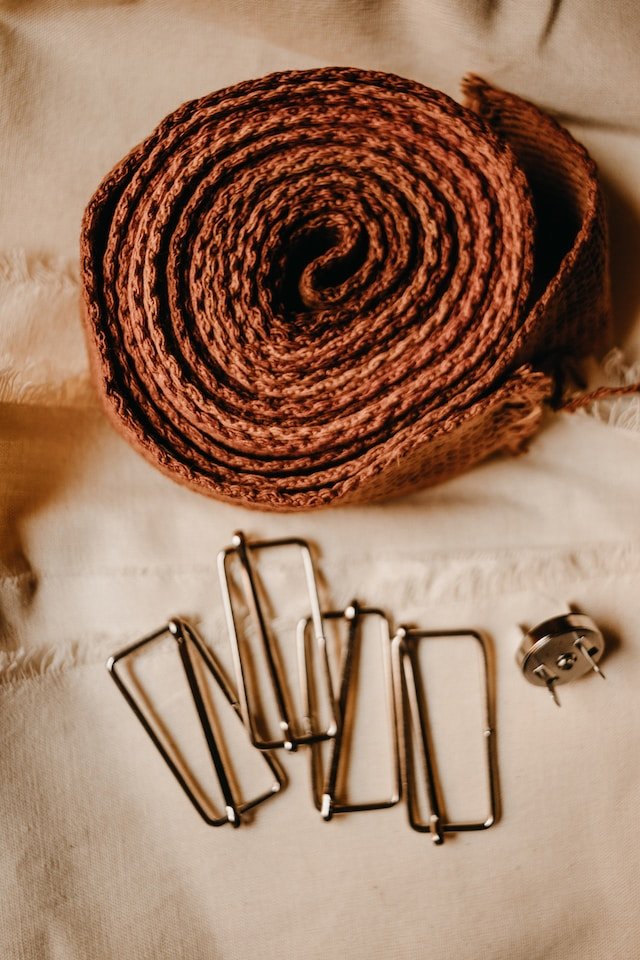Elevating your wardrobe doesn’t always require a trip to the store. With a bit of creativity and a few materials, you can craft a stylish and personalized accessory right at home. In this article, we’ll explore the world of DIY fabric belts – a simple yet impactful way to add flair to your outfits. Join us on this creative journey as we delve into easy techniques, unique ideas, and step-by-step instructions to make a belt from fabric.
Gathering Materials:
To embark on your fabric belt DIY adventure, you’ll need:
Fabric of your choice
Fabric scissors
Measuring tape
Iron and ironing board
Sewing machine or needle and thread
D-rings, belt buckle, or any preferred closure
Classic Fabric Wrap Belt:
Start with a classic fabric wrap belt that’s versatile and easy to make. Cut a strip of fabric twice the desired width and add a few inches for seam allowance. Sew the long edges together, turn the fabric inside out, and press. Attach D-rings or a belt buckle to one end, and you have a simple yet stylish fabric belt.
Obi Style Belt:
Embrace the elegance of an obi-style belt by creating a wide, statement piece. Cut a longer and wider strip of fabric, wrap it around your waist, and tie it in a bow or knot at the front. This style adds a touch of drama to dresses or loose-fitting tops.
Woven Fabric Belt:
Experiment with a woven fabric belt to add texture and interest to your ensemble. Cut thin strips of fabric and weave them together to create a unique pattern. This technique allows you to play with colors and textures, resulting in a one-of-a-kind accessory.
Boho Fringe Belt:
Infuse a bohemian flair into your wardrobe by adding fringe to your fabric belt. Cut thin strips along one edge of the fabric, leaving them unsewn for a free-spirited fringe effect. This playful detail works well with casual outfits or to add a touch of whimsy to a simple dress.
Ruffled Edge Belt:
Elevate your fabric belt with a touch of femininity by adding a ruffled edge. Sew or gather the fabric along one edge to create a subtle ruffle. This style works beautifully with dresses or high-waisted skirts, bringing a soft and romantic vibe to your look.
Embroidered Fabric Belt:
Personalize your fabric belt by incorporating embroidery. Choose a fabric with a solid color or subtle pattern to serve as a canvas for your embroidery. Add delicate stitches, patterns, or even your initials to create a belt that truly reflects your style.
Double-Wrap Belt with Bow:
Create a chic and sophisticated look by making a double-wrap belt with a bow. Cut two narrower strips of fabric, wrap them around your waist, and tie them in a bow at the front. This style adds a polished touch to dresses or tailored blouses.
Velvet Ribbon Tie Belt:
Combine the luxurious feel of velvet with the simplicity of a ribbon tie belt. Cut a strip of velvet fabric, sew the ends, and add ribbon ties. This elegant accessory works well for eveningwear or to add a touch of opulence to a casual outfit.
Lace-Trimmed Fabric Belt:
Infuse a touch of vintage charm by adding lace trim to your fabric belt. Attach lace along the edges or as a decorative accent in the middle. This delicate detail adds a romantic and feminine touch to your belt, making it a standout accessory.
Tassel Detail Fabric Belt:
Enhance your fabric belt with tassel details for a boho-chic vibe. Attach tassels at regular intervals along the length of the belt. This playful addition brings movement and a relaxed feel to your outfit, making it perfect for summer or festival looks.
Contrast Stitching Belt:
Highlight the details of your fabric belt by incorporating contrast stitching. Choose a thread color that complements or contrasts with the fabric, and sew visible stitches along the edges or in decorative patterns. This technique adds a tailored and eye-catching element to your accessory.
Geometric Print Fabric Belt:
Opt for a modern and bold statement by using a fabric with a geometric print. Cut the fabric into a classic belt shape, allowing the print to take center stage. This contemporary design adds a touch of sophistication to a variety of outfits.
Braided Fabric Belt:
Channel a rustic and artisanal vibe by creating a braided fabric belt. Cut three long strips of fabric, braid them together, and secure the ends. This DIY belt adds texture and visual interest to casual outfits, giving them a laid-back and handmade feel.
Wrap-Around Fabric Belt with Beads:
Elevate your fabric belt with bead embellishments for a touch of bohemian charm. Sew or glue small beads along the length of the belt, creating a subtle and eye-catching detail. This accessory works well with flowy dresses or tunics.
Printed Scarf-Tie Fabric Belt:
Unleash your creativity by using a printed scarf as the material for your fabric belt. Choose a vibrant and patterned scarf, and fold or cut it into a strip. Tie it around your waist, creating a chic and eclectic belt that can be easily adjusted to suit various outfits.
Nature-Inspired Leaf Belt:
Bring a touch of nature into your wardrobe by crafting a fabric belt with leaf-inspired details. Cut leaf shapes from a contrasting fabric or felt, sew or glue them onto the belt, and create a botanical-inspired accessory that adds a whimsical and organic element to your ensemble.
Conclusion:
Making a belt from fabric opens up a world of possibilities for expressing your personal style and adding a unique touch to your outfits. Whether you prefer the simplicity of a classic wrap belt or the bohemian charm of a fringe or tassel detail, DIY fabric belts are a versatile accessory that can be customized to suit any occasion.
FAQs:
Can I use scrap fabric for making a fabric belt?
Absolutely! In fact, using scrap fabric is a great way to reduce waste and create a sustainable accessory. Mix and match different fabric scraps for a colorful and eclectic look.
What’s the best fabric for a fabric belt?
Cotton, linen, and canvas fabrics work well for fabric belts due to their durability and ease of handling. However, you can experiment with various fabrics like velvet, silk, or even denim for different textures and styles.
Do I need advanced sewing skills to make a fabric belt?
Not at all! Many fabric belt styles can be created with basic sewing skills. Start with simpler designs, and as you become more comfortable, you can experiment with more intricate techniques.
How do I determine the length of the fabric belt?
Measure your waist or the desired placement for the belt and add a few inches for overlap and closure. Consider whether you want a loose or snug fit, and adjust the length accordingly.
Can I make fabric belts for kids using the same techniques?
Absolutely! The same techniques can be adapted for making fabric belts for kids. Adjust the length and width based on the child’s size, and opt for playful colors and patterns to suit their style.
What type of closures can I use for my fabric belt?
The choice of closure depends on your preference and the overall style of your belt. D-rings, belt buckles, snaps, or even tying the ends into a knot are common closures. Choose one that complements the design and functionality of your fabric belt.
How do I ensure my fabric belt stays in place without constant readjustment?
Consider the width and material of your fabric belt. A wider belt tends to stay in place better than a narrow one. Additionally, choosing a fabric with a bit of grip, like cotton or canvas, can help prevent slipping and the need for constant readjustment.



